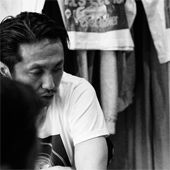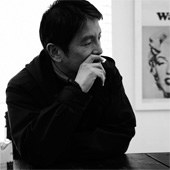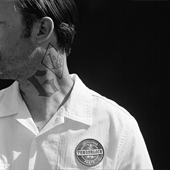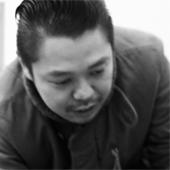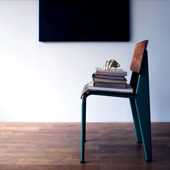
どちらもすごく面白いと思っています。まだデジタルをほとんど使わないですけど…。今の自分にとってデジタルって、写真に対するアイデアを固くさせると思うんです。発想とか技術に関しては、写真に対してもっと自由で柔らかくあっていいと思う。撮影の途中にモニタで撮った写真を確認できてしまうと、次のアイデアは想定内のものしか生まれないと思うんですよ。もちろん、思っているものが生まれるという完成度はすごくポジティブなことだとも思います。でも例えばマーク・ボスウィックのように、フィルムの途中でカメラの蓋を空けて感光させてしまうとか、何が映るのかわからないけどカメラを揺らしながら撮るとか、何でもありなんです。使うフィルムを土の埋めて腐らせるとか…。そんなふうに自由に考えて突拍子も無いことが写真上で起こることのほうが今は面白く感じます。もちろんそこにロジックはありきですが。抽象的な言い方ですが、デジタルでその発想が固くなってるものが多くて、もう少し柔らかくならないかと思ってます。
例えば、カメラメーカーの作ったデジタルカメラのカラープロファイルがあって、カメラの性能がよくて現像ソフトも優秀で、最終的にPhotoshopで画像をイジる、と。それって、ものすごくレールが敷かれていますよね。失敗がない感じ。それに比べてアナログの作業って、平気で失敗するから緊張感があるしカメラにすごく個性があって、昔はフィルムにも個性があって、引き延ばし機のレンズや、そこに現像方法やプリントなどの手作業が入ってきて、温度や水の環境という自然までもが関係してくる。その自由度というか、プログラムが介入してこない感じが最大の魅力ですね。
昨年末のパリフォトで、ダイアン・アーバスが自分で焼いたプリントを見た時に、その強さに圧倒されてしまったんですよ。いくらデジタルの写真データが何十テラバイトとか大きくなろうが、アナログとの違いは明らかなんじゃないかなと痛感したんです。でも、デジタルってものすごいスピードで進歩しているから、信じられない技術が近いうちに開発されて、パラダイムシフトが起こってそういうアナログの神秘的な良さがデジタルで表現できる時代が来るかもしれないけど、2012年の今はまだだな、と。デジタルカメラの技術が今のアナログに匹敵するぐらいになれば、いくらでもデジタルを使いますしね。個人的には、デジタルというジャンルがすごく好きだし、役割として今、自分が写真でできることはアナログというだけです。
今の若い人たちが、町のラボでサービスサイズにプリントすることを「写真にする」って言い方をすると聞いたことがあります。パソコンの中に入っている写真はデータなのでその段階では画像で、記憶メディアの中に入っているだけで一向に写真にならない。プリントして初めて写真になって記録されるということを、今の世代の子たちも無意識にわかっているんだと思います。
結果、写真には自分の根底にあるものしか出てこないと思う。それを表現するプロセスは自由ですから。鳥は、風を読み、空中を自由に移動して飛んでゆく。そんな感じに憧れてるのかもしれないですね。
I find both very fascinating, although I hardly use digital… For my current self, digital would make my ideas towards photography stiff. Regarding the ideas and techniques, I believe overall that it should be more free and flexible. When we can see the photograph that we just took on the monitor during a shoot, I think that the next idea can only be something too thought-out. Of course, I think that the quality of being able to get what we envision is very positive. However, taking Mark Borthwick as an example, you can open the cover of the camera while in the middle of the film and exposing it, or taking pictures while you shake the camera not knowing what it would capture – you can do whatever you want. You can even bury the film that you would use in the ground and rot… By thinking freely and getting something unexpected in the photos, that is what’s the most fun for me at the moment. Of course this has to be based off logic, as well. This is an abstract way of putting it, but I feel there are many digital works which ideas are stiff because of it, and I wish they could become more flexible. For instance, camera manufacturers have now made color profiles for the digital camera, the overall ability of cameras is very high; developing software is excellent; and then in the end we would edit the images on Photoshop. This sets up many obstacles– feeling that there is no possibility of mistakes. In contrast, working in analog, one can easily make mistakes hence there is sense of tension, and all of the cameras are all very unique. In the past film had distinctive characteristics, the lens of the enlarger, the technique of the developing and printing process, and the environment of the temperature and the state of the water all would become relative. That sense of freedom or awareness of not having a program interfere is the greatest appeal. During Paris Photo at the end of last year, I was overwhelmed by the intensity of Diane Arubus’ photography which she printed herself. I strongly realized that the size of digital data could become however many terabytes, the difference with analogue would always be apparent. However, digital continues to grow at a tremendous speed, so unbelievable technology will be invented in the near future, causing a paradigm shift so that digital can express the mysterious quality that analog has, but in 2012, we are not there yet. If the technology of digital cameras becomes a match for what analog is now, I would heavily use digital. Personally, I really like the genre of digital photography; it’s just that currently I believe what I can accomplish with my photography is by analog.
I have heard that young people nowadays say to “make into a photo” when they are printing photos in a service size at a lab somewhere in town. The photos in the computers are just merely data, so they are images at that level, but they are not photographs on a memory device. By printing they would then become and recognized as a photo for the first time – I think the young generation has now unconsciously learned this.
Consequently, I think that photographs only reflect what’s in the core of yourself. The process of the expression is unrestricted. Birds read the air, and they freely explore the sky and fly. You could say I envy that sensation.
1975年東京生まれ、フォトグラファー。祖父と父から写真家の系譜を継承する三代目。東京工芸大学写真学科卒業後、1998年独立。アナログカメラを駆使したランドスケープ写真やポートレイトを中心に、情景のある写真作品を独自に探求。現在は雑誌・カタログ・広告のファッションポートレイトで活躍。http://www.bnm-jp.com/
born in Tokyo, 1975, photographer. The third generation inheriting from father and grandfather. Became freelance in 1998 after graduating from Tokyo Polytechnic University – Department of Photography. Utilizing analog camera in landscape, portraits, pursues what his photography can emote. Currently specializes in fashion portraits for magazines, catalogs, and advertisements.http://www.bnm-jp.com/


















